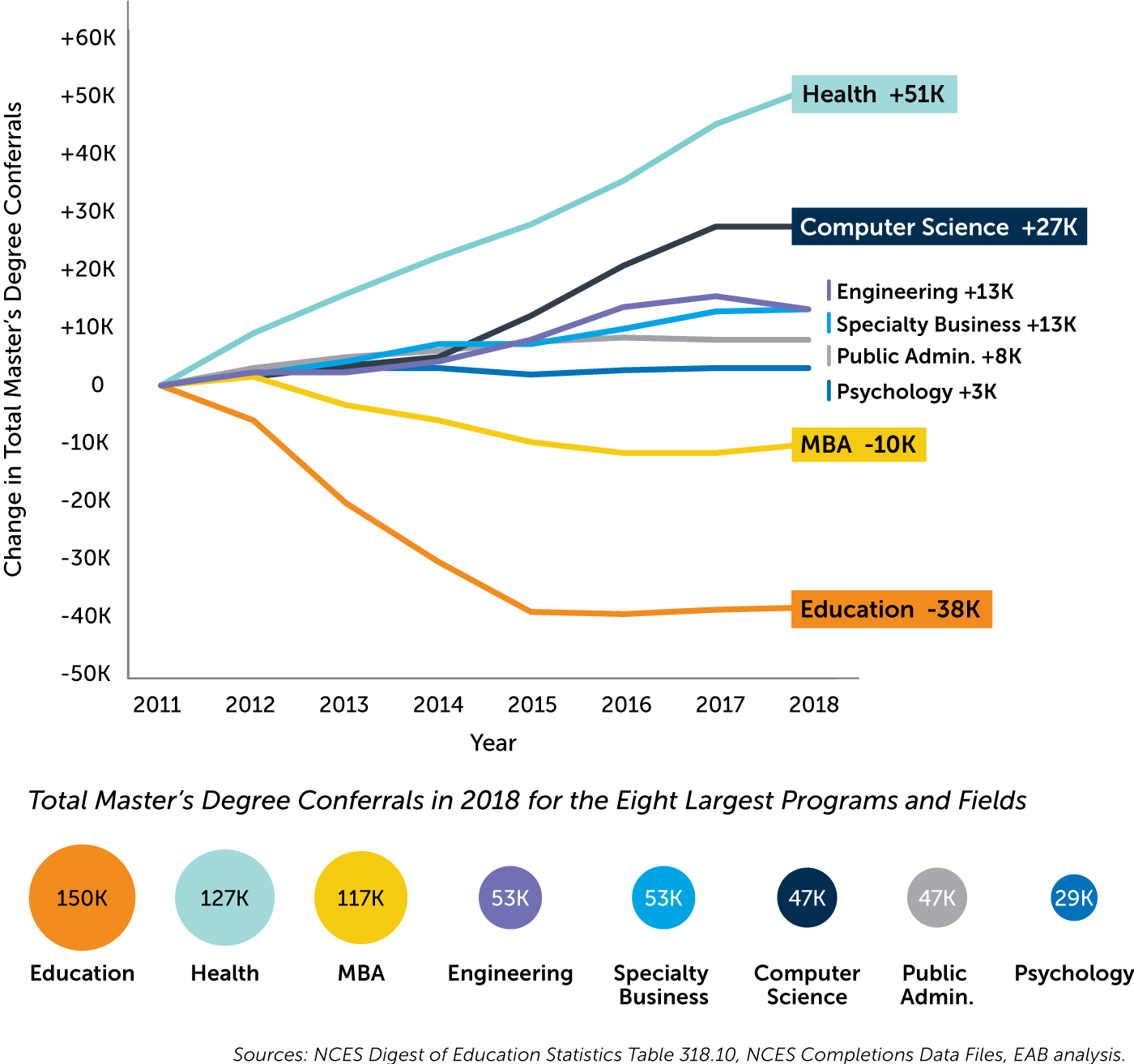You have /5 articles left.
Sign up for a free account or log in.

Istockphoto.com/skodonnell
The explosion of new master’s degree programs in recent years hasn’t corresponded with a surge in students, analysis by the research and technology services company EAB suggests.
Megan Adams, managing director of research at EAB, said many colleges have overestimated the popularity of new degree programs. They may anticipate awarding hundreds of degrees per year, but the true number is often a single digit, she said.
It’s no secret that the master’s degree market has become increasingly competitive. Dozens of colleges are starting degrees online and on campus in hot areas such as cybersecurity and data science. But the market is not as healthy as many college leaders believe it to be, said Adams.
The National Center for Education Statistics has lowered its expectations for master’s degree growth every year for the past five years. The projected 10-year annual growth rate in 2014 was 2.8 percent. The actual growth rate of master’s degree conferrals in the U.S. from 2013 to 2018 was 1.7 percent.
“In 2014, what were bullish projections of over a million master’s degree conferrals annually by 2024 steadily dropped to a projected 840,000 master’s degree conferrals by 2029. That’s almost 200,000 fewer master’s degrees conferred,” wrote Adams in a recent blog post in which she argues that the master’s degree market is a bubble that has “already burst.” The blog post is the first in a series that will discuss trends and changes in the master’s degree market.
“If we assume that, on average, a master’s program still takes two years to complete, every potential conferral represents two potential students,” said Adams. “That’s almost 400,000 fewer master’s students projected in the market, and what we’ve estimated as roughly $7.2 billion less master’s degree tuition revenue in the market over all.”
Increased competition for students, a strong job market and a plethora of nondegree credentials may all have contributed to a market slowdown, said Adams. Postsecondary enrollment generally is countercyclical to the health of the economy. This was evident during the 2008 recession, when college enrollment rose. But in 2014, the effects of the recession started to wane, she said.

At the program level, the picture becomes more complex. Up until 2011, nearly every major master’s degree field was growing. But in 2011, the market split. Degrees in computer science, engineering and the health professions grew, while most other fields declined.
“The breakaway growth in some programs might seem like a bright spot, but high-growth programs in computer science, engineering and health care fields are also some of the most expensive to deliver,” wrote Adams. “The costs to recruit faculty make it challenging for many institutions to offer these programs or to prevent costs from outpacing revenues.”

Trace Urdan, managing director at Tyton Partners, agrees that the growth in the master’s degree market is a bubble fueled by the “basically unlimited funding” offered by Grad PLUS loans. But he doesn’t agree that the bubble has burst, at least not yet. Growth could easily pick up if the economy took a downward turn, he said.
Urdan said it would have been interesting for Adams to consider the role of online program management companies in her analysis. “To me, it’s OPMs that are the big story of the last five years in the graduate market,” he said.
Leaders of large OPM companies, such as 2U, have talked openly about the dramatic slowdown they have recently experienced. “All of a sudden it’s gotten way more expensive to acquire students. There’s a lot more competition than there was," said Urdan.
Bob Atkins, CEO and founder of Gray Associates, also disagrees with the burst-bubble theory.
“The market is still growing. It’s not declining,” he said. “I don’t think a bubble has burst. That implies a dramatic drop, which has not occurred and probably won’t. The growth rate may be slowing, relative to the recession. But the chart suggests that actual conferrals are rising again after a pause in 2015.”
The market is highly competitive, and it can be costly to attract students, but it is possible to make “reasonably good predictions” of enrollment in the short term if you look at the right data, said Atkins. “If you’re getting bad results, you have a bad method,” he said. Both Gray Associates and EAB advise colleges on business strategy.
Josh Kim, director of online programs and strategy at the Dartmouth Center for the Advancement of Learning and a blogger for Inside Higher Ed, said it is clear it is becoming "more challenging for master's programs to build demand. This is especially true for specialized master's programs, and for master's degrees that don't carry a highly recognizable global brand. At the same time, we are seeing demand for nondegree online programs, as well as low-cost online degrees, go through significant expansion."
The secret to launching successful degree programs is not to treat master's degree programs as golden geese or cash cows, said Kim.
"For many schools, the best solution will be to develop small master’s degrees around the differentiating expertise of the faculty," said Kim. "These master’s programs should be thought of as strategic investments by their institutions, as they establish areas of expertise and specialization. The goal of these programs should be financial sustainability."
"It is also a mistake for schools to develop master’s degrees simply to chase a market. Demand can shift," he said. "A better strategy is for a school to play to their strengths and to create master’s that aligns with an institution's mission and values."




